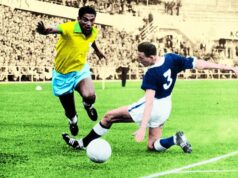By David Rodich
With all the top teams dropping midweek points, Inter faced Bari Thursday with hopes of making up ground in the table.
Despite a downright ugly opening 60 minutes of the match, which was marred by the dark side of Italian football (crybaby drama, punches behind the ref’s back and all around inelegant play), Inter prevailed as their playmaker talisman Wesley Sneijder made his return from injury and salvaged the final 30 minutes of the match.
Surely Leonardo was hoping to save Sneijder for Inter’s big match against Roma on Sunday, but since they desperately needed the points, the Dutchman was brought on Thursday. And just after 10 minutes, the Nerazzurri broke the deadlock as Kharja, off a 1-2 with Eto’o, found the back of the net from close range. Then in extra time Inter found two more goals – one from Pazzini and one from Sneijder to make the final score 3-0.
Not only was Sneijder’s presence a bonus; just as important was the change in formation that accompanied it. Leonardo had started with something of a 4-3-3 with Pazzini in the middle, Eto’o on the left, and Milito on the right. In theory it sounds ok – more attackers equals more attack. Well, not so simple in this case. Here are the problems: First of all, Milito is effective in front of goal. He’s not a winger or a midfield playmaker. Secondly, Eto’o is indeed effective out on the left where he was stationed, but he’s more potent as a striker drifting out wide and confusing defenders than as a statically positioned winger. Finally, as is the danger with 4-3-3’s, there was a wasteland gap between the quite defensive midfield and the attackers. This created a discontinuity that was not repaired until Sneijder came on and assumed his customary attacking-midfield position – acting as a go-between from the midfield and the strikers. It was only then that Inter asserted their dominance against this Bari side, a team that is surely doomed for relegation at the season end.






